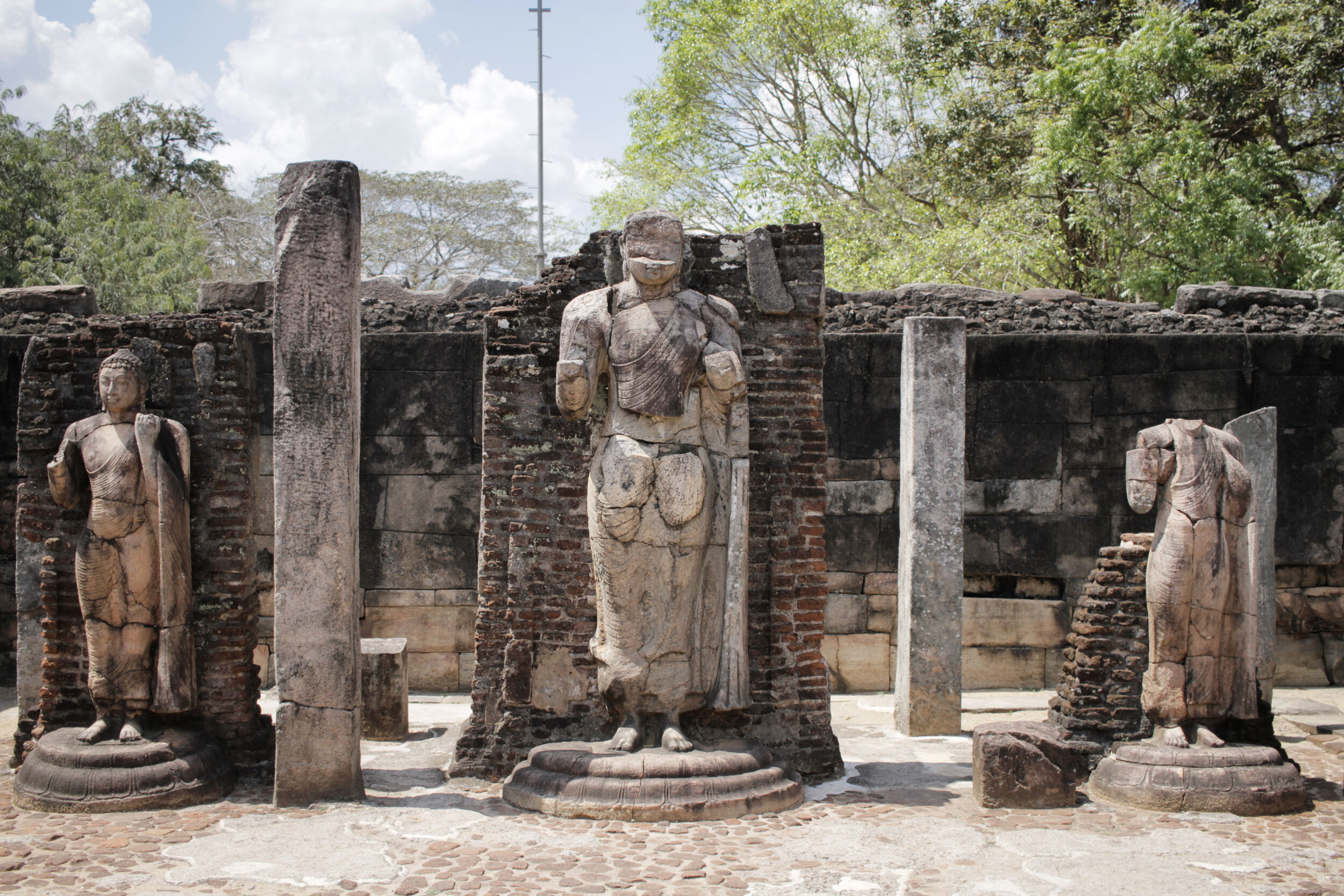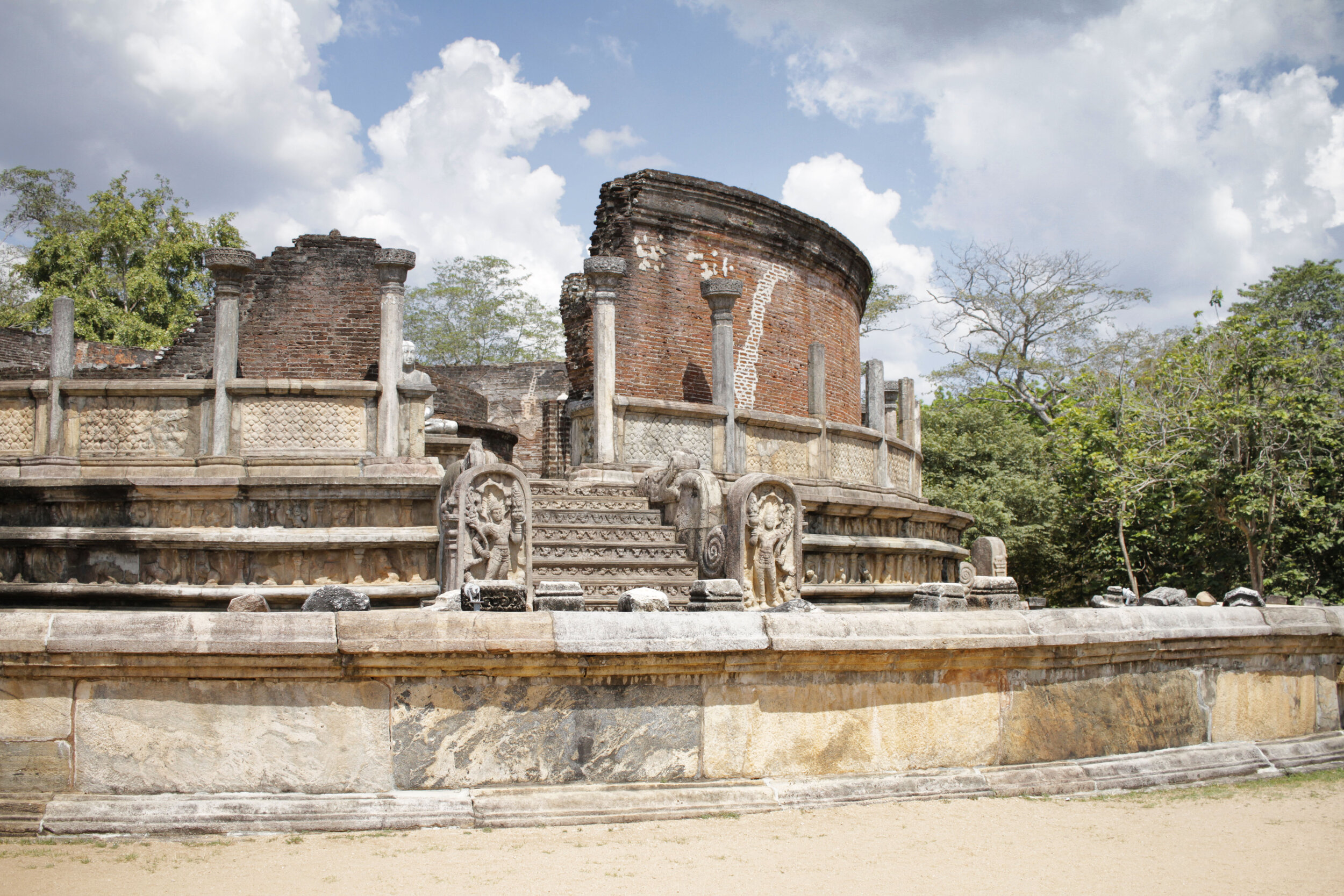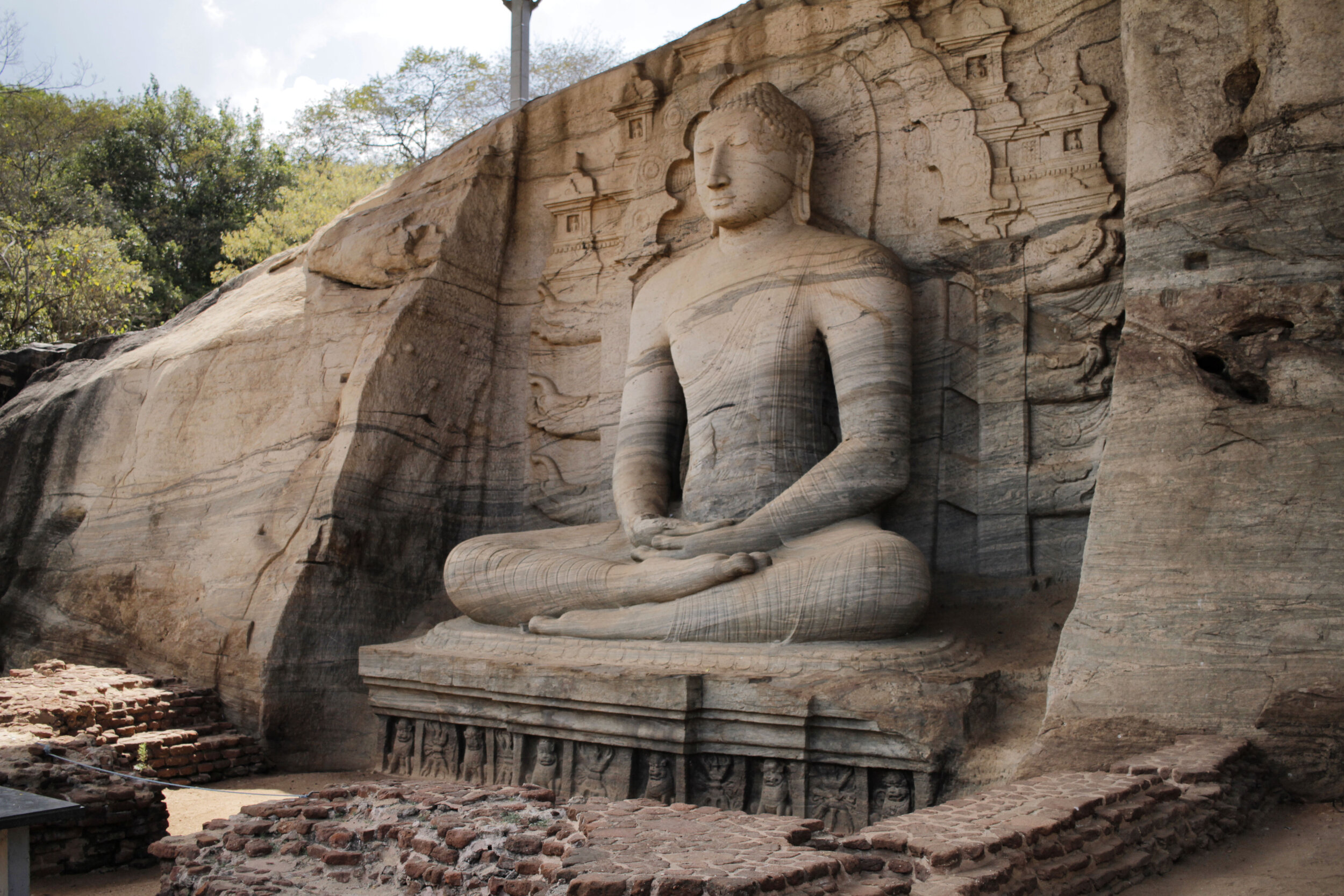Ancient City of Polonnaruwa
Best things to do in Polonnaruwa: honor well-preserved ruins of the ancient Sri Lankan capital with this travel guide.
In South Asia, the island country of Sri Lanka offers so much in the way of adventure. It’s a country littered with ancient ruins, breathtaking beaches and majestic wildlife.
But this island nation also has many other stories to uncover like being home to the world's oldest human-planted tree, its love for tea and cinnamon and the claim of having the highest literacy rate in South Asia.
Sri Lanka is a magical place that only requires an open heart and mind to truly enjoy.
Polonnaruwa was the second capital of Sri Lanka after the destruction of Anuradhapura in 993 and was a thriving commercial and religious center some 800 years ago.
It was first established as a military post by the Sinhalese kingdom and declared a UNESCO World Heritage site in 1982.
The site consists of many temples, palaces and religious buildings including The Palace of King Parakramabahu and Polonnaruwa Vatadage, a circular building made of brick consisting of two platforms holding a stupa (mound-like structure containing relics) in the middle.
Our whirlwind adventure in Sri Lanka began by circling the country clockwise, flying into the capital city of Colombo and moving on to an incredible experience elephant watching in Pinnawala.
From there, we climbed the eighth Wonder of the World (so they say) in Sigirya, taking a day trip to the ancient city of Polonnaruwa and enjoying a real life elephant safari at Minneriya National Park.
Our three weeks were rounded out by stops in Kandy with its giant Buddha, botanical gardens and fire dancing, Nuwara Eliya, also known as the “City of Light” and Ella for its impressive waterfalls, exciting train rides and lush mountains.
Our last two stops were Tissamaharama to visit Yala National Park and the sunny beach town of Mirissa for the historic city of Galle, whale watching and sunny beaches.
Best Things to Do in Polonnaruwa
Travel / To the ancient city of Polonnaruwa
Taste / Local Cuisine
Roam / Countless Ancient Temples
Vatadage
Hatadage
Nissank Latha Mandapaya
Thivanka Image House
Rankoth Vehera
Gal Vihraya
Kiri Vihara
Best Things to Do in Polonnaruwa
Travel to the Ancient City of Polonnaruwa
It was our second day at Palmyra Nature Hostel in Sigirya, spending the first visiting Lion’s Rock. Today would be a historical trip to the Ancient City of Polonnaruwa, about an hour east by car or double by tuk tuk.
Each morning, our hotel offered a delicious spread of coffee, fruit, sweets, toast and fried eggs to get the day started. After indulging ourselves, it was time to get moving.
Tip / Before entering the Ancient City of Polonnaruwa know that it’s hot; extremely hot. It’s best to dress accordingly and bring some water to help cool off. Also, there weren’t any vendors selling snacks so pack as needed or grab a bite before entering. Shade is pretty limited, so grab your favorite sun glasses, sunscreen and a light cover-up to protect your skin from burning.
Tip / Temples require guests to remove footwear and hats and cover to the knee, therefore revealing clothing isn’t the best option. Socks will be necessary so that your feet don’t burn on the sun soaked stone and sand. Either a tuk tuk or bike is helpful between sites as they are spread far apart. Our driver was paid to wait for us while we explored each temple and then give a lift over to the following site.
Taste Local Cuisine
On the way into the ancient site he was kind enough to drop by his friends house for a home cooked meal. As we pulled up to the small structure covered with a thatch roof, a small woman rushed around lighting each pot filled with delicious foods.
In Sri Lanka, curry is synonymous with sauce, so almost every hot dish is called curry. Curry pots, or mati walang, are shaped from red or black clay on a potter’s wheel and either fired in a kiln or sun dried for a few days. Traditionally, rice and curries are cooked in these clay pots and used to make one-dish wonders including fish, chicken, jackfruit and eggplant.
Everything served was absolutely incredible but definitely spicy. Even the sweet treats at the end of the meal were tasty, full of sugar and super gooey. It was such an amazing experience.
Roam Ancient Temples
Though scholars cite malaria as a possible cause for the abandonment of Polonnaruwa, today Modern Polonnaruwa is undergoing a major development project known as the "Awakening of Polonnaruwa" which focuses on enriching roads, agriculture, electricity, education, health and environment.
Tip / Grab tickets the Polonnaruwa Archaeological Museum ticket office and don’t miss what’s on display at the museum.
Upon arriving at the Ancient City of Polonnaruwa, first stop in the Polonnaruwa Archaeological Museum ticket office to purchase entrance tickets for $25 USD. Here, the museum houses artifacts from this medieval capital which are quite interesting by themselves. Take a quick look around and be on your way to some of the most incredible ruins that are sure to impress.
Vatadage
The first stop was the Vatadage, considered to be one of the epitomes of round-shaped structures and said to be the most popular trend in the Polonnaruwa period. After being abandoned for centuries it was unearthed in 1903 during archaeological excavations.
The circular building consists of a stupa, four Buddha statues, stone columns and two platforms. The inner platform has four entrances from the cardinal directions, each featuring beautifully carved stone staircases with guard stones on the sides.
There are two theories as to who built the Vatadage structure and why. There’s no argument that it was built to hold a relic of Lord Buddha but historians and archaeologists have yet to find the rightful builder of the structure.
Some claim it was built by King Parakramabahu I to hold the Sacred Tooth Relic of Buddha, while others argue it was King Nissankamalla to hold the Sacred Alms Bowl of Buddha.
Hatadage
Polonnaruwa Hatadage is also a shrine built to hold the Sacred Tooth Relic of Buddha but is different than the Vatadage. Most significantly, it’s said to have had two floors with only one remaining today.
Nissanka Latha Mandapaya
Nissanka Latha Mandapaya is a unique structure in the ancient kingdom famous for its unique architecture and stone carvings. The name ‘Mandapaya’ was given to structures open from all sides, with pillars supporting the roof to protect those inside from sun and rain. Most of these mandapas were built during ancient times for public activities or as entertainment centers within royal courts. It’s said that this mandapaya was built by the king to listen to incantation chanting by Buddhist monks.
The columns are the most interesting feature of the structure, arranged in two rows with four columns in each row. The columns are made of stone and beautifully carved with the head of each column shaped like a blooming lotus bud.
Unlike other pillars found from the Anuradhapura and Polonnaruwa eras, these pillars are not straight. Each of them is curved at three places, with the body of the column carved to resemble the stem of the lotus flower.
Thivanka Image House
Thivanka Image House or Thivanka Pilimage is a historical structure housing statues and paintings from the 12th century.
The walls and roof are built from bricks, so it’s known as one of the three Gedige (vaulted) image houses found in the area, the others being Lankathilaka Pilimage and Thuparama Pilimage.
Rankoth Vehera
Rankoth Vehera is a huge stupa considered to be the largest Buddhist stupa in the Ancient City of Polonnaruwa. It was built by King Nissankamalla and bears a close resemblance to the Buddhist stupas of the Anuradhapura kingdom.
Rankoth Vehera can be roughly translated as ‘the golden pinnacled stupa’. The entire stupa is built from brick, including the four structures used to offer flowers, and the wall surrounding the terrace of the stupa.
The structure stands 180 feet tall with a base diameter of 550 feet, although the original built by king Nissankamalla is said to be at least 200 feet tall.
Gal Viharaya
Gal Viharaya or ‘rock monastery’ is the most visited monument in Polonnaruwa. Earlier referred to as ‘Uttararama’, it’s said to be built by the greatest king of the Polonnaruwa era, king Parakramabahu I. ‘Uttararama’ translates to ‘the northern monastery’ and is recognized as the most prominent monastery built by king Parakramabahu during his reign.
Most notable are the four massive Buddha statues carved into the face of a large granite rock. Considered some of the best Sinhalese stone sculpting and carvings, the four figures consist of a large seated Buddha, small seated Buddha inside a man-made cave, large standing Buddha and a massive reclining Buddha.
The standing figure has a height of nearly 23 feet while the reclining figure reaches an amazing 46 feet 4 inches in length, making it one of the largest sculptures in South Asia. Historical inscriptions record that king Parakramabahu built three caves in the rock to commemorate the statues although only one of these are actual caves.
Gal Viharaya holds a massive significance to the Buddhist culture because it’s said to be the location where the king held a congregation of Buddhist monks to reconcile the divided three Buddhist priesthood fraternities.
Kiri Vihara
Kiri Vihara is part of the archaeological site Alahana Pirivena. Meaning ‘white milk’, its name comes from the original lime plaster that was in near perfect condition after 700 years of neglect in an overgrown jungle.
It’s construction is credited to Subhadra, King Parakramabahu I’s queen and it is still the best-preserved unrestored dagoba at Polonnaruwa. Considered the second biggest stupa in Polonnaruwa today, this stupa is the only one to survive 900 years of forces of nature and still remain in its original condition.
After visiting the majestic Kiri Vihara, it was time to head out of the Ancient City of Polonnaruwa. The hot dry weather and sunny skies had drained us fully of all energy.
On the way back to Sigiriya we made a quick stop at a huge Buddha statue near a lake; it was quite gorgeous.
Next up, the following day would be a magical elephant safari at Minneriya National Park about 30 minutes north of Sigiriya. Minneriya National Park was originally declared a wildlife sanctuary in 1938 and is mostly known for its incredible elephant migration.



































